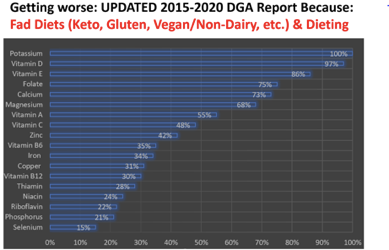Lifespan, Healthspan and Playspan
Humans are living longer than ever before with the help of modern medicine, science, technology, and access to adequate nutrition. Although the human lifespan can now extend past the century mark, healthspan, which is the time spent with good health, is markedly shorter for the majority of Americans inflicted with diseases related to lifestyle and aging.
Overweight and obesity affects 7 out of 10 adults and drastically increases the risk of developing a chronic disease. With a current U.S. population of 327.2 million, that means a lot of people will suffer from at least one chronic disease at some point in their life. At present, cardiovascular disease is the number one cause of death. Other common diseases and conditions, including diabetes, sarcopenia and osteoporosis, all impair your ability to maintain a high quality of life, such as the ability to perform activities of daily living without assistance.
Your Playspan, which refers to the ability to stay physically active and do the things you enjoy late into adulthood, takes a backseat when you’re inflicted with a chronic disease.
What if there was a way to mitigate functional, structural and possibly cognitive decline during aging, allowing people to stay active and “play” as long as they’re alive? Enter stage right - nutrition with intention.
If you are an online nutrition coach or in-person, nutrition with intention is especially important in these days of hardship.
Exercise Sets the Stage, but Nutrition Makes the Movie
The myriad of benefits that exercise has on health parameters, functional strength and performance are well established, whereas nutritional strategies intended to extend one’s Playspan appear to be less well known and underutilized in fitness and the general population.
It’s no secret that exercise serves as the trigger to induce the desired outcome – whether that’s increasing strength, building muscle, decreasing fat mass or any combination of physical performance and body composition changes. It’s a catabolic process designed to stress muscle tissue and related systems to force the body to adapt. Simply put, exercise sets the stage. What goes into the body, or one’s nutrition, determines what happens next. Since nutrition is 100% anabolic, it is what makes the movie.
- Good nutrition = good movie.
- Bad nutrition = not so good movie.
- Same nutrition = same movie.
I’m sure you can think of several gym members who exercise diligently for years, yet their body does not change. Point made, right? However, the power of exercise combined with intentional nutritional strategies goes well beyond maintaining a healthy weight, which is a cornerstone of a long Playspan. Other keys to optimizing your Playspan include:
- Adequate protein across your lifespan to support muscle tissue, stave off age-related sarcopenia and maintain functional independence
- Meeting daily requirements of the essential micronutrients across your lifespan, as established by the Dietary Reference Intakes, including the Recommended Dietary Allowances (RDAs)
Assuming regular exercise, including resistance training, is setting the stage, let’s dig a little deeper into what it takes to make a good movie.
Protein – Minimal vs. Optimal
The current RDA for protein is 0.8 g/kg of body weight, or 0.36 g/lb. This minimum amount is arguably inadequate to prevent age-related decline in muscle and should be higher for older individuals, who are more likely to develop anabolic resistance or a decreased anabolic response to protein and resistance training, compared to younger counterparts.
Protein intakes greater than the RDA have been shown to help maintain protein balance and improve body composition outcomes. A 2018 review of 49 trials by Morton (1) demonstrated that protein supplementation, particularly whey protein, appears to help regular exercisers increase strength and lean body mass when compared to placebo or no supplements over a period of six weeks or longer. These benefits were seen with daily protein intakes of up to 1.62 g/kg of body weight, or 0.73 g/lb. Once again, exercise is catabolic and increases tissue turnover, so it makes sense that active people would benefit from more. In this case, minimal is not optimal.
No, protein supplements are NOT necessary, but they’re certainly helpful, especially before and after exercise.
One of the reasons has to do with the specific combination of muscle building blocks, or essential amino acids (EAAs) contained in whey protein. The wide array of EAAs in whey, including the branched chain amino acid leucine, which turns on the muscle building process, is ideal, not to mention convenient and easily digestible. It’s a practical way to reach higher protein intakes that have been shown to be beneficial.
Therefore, be sure to consume adequate protein on a daily basis, which is at least .73 g/lb. or approximately 1 gram per pound of lean body mass. Higher amounts have been shown to benefit those seeking to maximize muscle gain and/or promote fat loss while in a calorie deficit.
Micronutrients – Beyond the Macros
Providing the right amount of each macronutrient has been a key focus among fitness professionals, whereas meeting micronutrient needs is less of a focus, despite the fact that they are essential for all aspects of growth, development, health and metabolism, and that shortages have been linked to higher risk of disease, such as obesity, heart disease, cancer and osteoporosis.
Of all the human essential nutrition, vitamins and minerals are the most difficult to attain in proper amounts (RDAs), leaving us vulnerable at any life phase to creating a weaker structure, thus opening the door to modern day health and lifestyle issues. These optimal amounts were not known or available during periods of significantly shorter lifespans, but are now known and necessary to support our current lifespan’s potential health.
Data has shown that Americans continually fall short on key essential nutrients, and chronic insufficient intakes of vitamins and minerals not only open the door to early disease and aging, but often go unnoticed until it’s too late. For example, 73% of Americans do not meet their daily needs for calcium and it’s even higher for vitamin D3, also required for bone health. As a result, osteoporosis can eventually set in, and will likely go unnoticed until it’s too late when a fracture or fall occurs.
The most recent Dietary Guidelines for Americans (DGA) report (2) revealed nutrient insufficiencies for several vitamins and minerals (see chart below). By definition, these micronutrients must be obtained through the diet since the body does not synthesize them. Scientists have established the daily requirements (RDAs) to prevent disease and support health.
See also: Micronutrients - How Chronic Shortages Lead to Health Problems

Similar to calcium, there are repercussions in the body that go unnoticed without an overt deficiency when any of these essential nutrients are not delivered consistently throughout one’s lifespan. Not only are people failing to consume adequate amounts of these vitamins and minerals, but adopting a weight loss diet exacerbates micronutrient insufficiencies. In a study by Calton (2010) (3) in which four popular diet plans were analyzed, each diet failed to provide sufficient amounts of 27 essential nutrients.
Therefore, a wise nutritional strategy to support overall health, decrease risk for disease and optimize Playspan is to meet daily requirements of all essential vitamins and minerals. Since most people fall short with food alone, a daily low-dose multivitamin and mineral is a commonsense solution to filling nutrient gaps. If one’s diet does not provide adequate amounts of calcium, vitamin D or the essential omega-3 fats (DHA and EPA), supplementation can help meet those needs. This is even more critical during weight loss.
Summary
To sum things up, optimizing your Playspan with intentional nutritional strategies includes the following:
- Set the stage with regular exercise, including resistance training
- Make a good movie with these essential acts:
- Act 1 - Consume approximately 1 gram of high-quality protein per pound of lean body mass daily. Ideally, split doses evenly throughout the day. A protein supplement isn’t necessary, but has shown to be beneficial and convenient, especially before and after workouts.
- Act 2 - Take a high-quality, low dose daily multivitamin and mineral from womb to tomb to fill unavoidable gaps. The formula should contain approximately 20-22 micronutrients to reach the RDAs.
- Acts 3 - Consume at least 8 ounces of fatty fish, such as salmon, mackerel and herring, weekly to get 500-600 mg of the essential omega-3 fats EPA and DHA. Supplement if needed to mimic the omega-3 index of people with lower disease risk
- Act 4 - Consume at least three servings of calcium rich foods daily, which equates to 1,000 – 1,200 mg/d. If not, supplement to achieve these amounts.
Tapping into the power of exercise and nutrition goes beyond calculating macronutrients. Data continues to accumulate that exercisers and older individuals benefit from more than the minimum recommended amount of protein, and that Americans are falling short of essential micronutrients. Using this data and intentional strategies provides a simple and effective way to help our clients’ lifespan match their Playspan so they have the best chance of staying active and independent until the end.
References
1. Morton RW, Murphy KT, McKellar SR, Schoenfeld BJ, Henselmans M, Helms E, Aragon AA, Devries MC, Banfield L, Krieger JW, Phillips SM. A systematic review, meta-analysis and meta-regression of the effect of protein supplementation on resistance training-induced gains in muscle mass and strength in healthy adults. Br J Sports Med. 2018 Mar;52(6):376-384. doi: 10.1136/bjsports-2017-097608. Epub 2017 Jul 11.
2. U.S. Department of Agriculture and Health and Human Services. (2015). Dietary guidelines for Americans 2015-2020, 8th edition. Retrieved from https://health.gov/dietaryguidelines/2015/resources/2015-2020_Dietary_Guidelines.pdf
3. Calton JB. Prevalence of micronutrient deficiency in popular diet plans. J Int Soc Sports Nutr. 2010 Jun 10;7:24. doi: 10.1186/1550-2783-7-24.

















